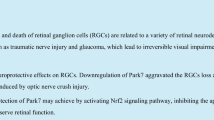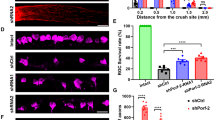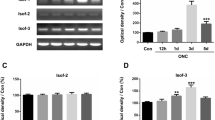Abstract
Purpose
To determine whether P7C3-A20, a proneurogenic neuroprotective agent, can protect the retinal ganglion cells (RGCs) of rats from optic nerve crushing.
Methods
The left optic nerve of 67 rats was crushed, and 5.0 mg/kg/day of P7C3-A20 (crush-P7C3) or its vehicle (crush-placebo) was injected intraperitoneally for 3 days from one day prior to the crushing. The protective effects were determined by the number of Tuj-1-stained RGCs and by the ratio of the mRNA levels of BAX/Bcl-2 on day 7. The levels of NAD and NAD-related genes were also determined.
Results
The density of RGCs was 2009.4 ± 57.7 cells/mm2 in the sham controls; it was significantly lower in the crush-placebo group at 979.7 ± 144.3 cells/mm2 (P < 0.0001). The neuroprotective effects of P7C3-A20 was demonstrated by the significantly higher density of 1266.0 ± 193.1 cells/mm2 than in the crush-placebo group (P = 0.01, Scheffe). After crushing the optic nerve the BAX/Bcl-2 ratio was higher in the optic nerves and retina, application of P7C3-A20 significantly reduced this ratio. P7C3-A20 significantly increased the NAD level in the untouched optic nerves from 1.36 ± 0.05 to 1.59 ± 0.10 nmol/mg protein (P = 0.02, t test). Crushing the optic nerve decreased the level to 1.27 ± 0.21 nmol/mg protein and P7C3-A20 preserved the level at 1.43 ± 0.10 nmol/mg protein. Crushing the optic nerve decreased the mRNA levels of Nampt and Sirt-1 in the optic nerves, while P7C3-A20 significantly restored the levels.
Conclusions
P7C3-A20 can protect RGCs from optic nerve crushing possibly through preserving the NAD levels in the optic nerves.




Similar content being viewed by others
References
Lunn ER, Perry VH, Brown MC, Rosen H, Gordon S. Absence of wallerian degeneration does not hinder regeneration in peripheral nerve. Eur J Neurosci. 1989;1:27–33.
Wang JT, Medress ZA, Barres BA. Axon degeneration: molecular mechanisms of a self-destruction pathway. J Cell Biol. 2012;196:7–18.
Mack TG, Reiner M, Beirowski B, Mi W, Emanuelli M, Wagner D, et al. Wallerian degeneration of injured axons and synapses is delayed by a Ube4b/Nmnat chimeric gene. Nat Neurosci. 2001;4:1199–206.
Conforti L, Wilbrey A, Morreale G, Janeckova L, Beirowski B, Adalbert R, et al. WldS protein requires Nmnat activity and a short N-terminal sequence to protect axons in mice. J Cell Biol. 2009;184:491–500.
Howell GR, Libby RT, Jakobs TC, Smith RS, Phalan FC, Barter JW, et al. Axons of retinal ganglion cells are insulted in the optic nerve early in DBA/2J glaucoma. J Cell Biol. 2007;179:1523–37.
Wang J, Zhai Q, Chen Y, Lin E, Gu W, McBurney MW, et al. A local mechanism mediates NAD-dependent protection of axon degeneration. J Cell Biol. 2005;170:349–55.
Sasaki Y, Vohra BP, Lund FE, Milbrandt J. Nicotinamide mononucleotide adenylyl transferase-mediated axonal protection requires enzymatic activity but not increased levels of neuronal nicotinamide adenine dinucleotide. J Neurosci. 2009;29:5525–35.
Pieper AA, Xie S, Capota E, Estill SJ, Zhong J, Long JM, et al. Discovery of a proneurogenic, neuroprotective chemical. Cell. 2010;142:39–51.
Wang G, Han T, Nijhawan D, Theodoropoulos P, Naidoo J, Yadavalli S, et al. P7C3 neuroprotective chemicals function by activating the rate-limiting enzyme in NAD salvage. Cell. 2014;158:1324–34.
Yin TC, Britt JK, De Jesus-Cortes H, Lu Y, Genova RM, Khan MZ, et al. P7C3 neuroprotective chemicals block axonal degeneration and preserve function after traumatic brain injury. Cell Rep. 2014;8:1731–40.
Dutca LM, Stasheff SF, Hedberg-Buenz A, Rudd DS, Batra N, Blodi FR, et al. Early detection of subclinical visual damage after blast-mediated TBI enables prevention of chronic visual deficit by treatment with P7C3-S243. Invest Ophthalmol Vis Sci. 2014;55:8330–41.
Tesla R, Wolf HP, Xu P, Drawbridge J, Estill SJ, Huntington P, et al. Neuroprotective efficacy of aminopropyl carbazoles in a mouse model of amyotrophic lateral sclerosis. Proc Natl Acad Sci U S A. 2012;109:17016–21.
De Jesus-Cortes H, Xu P, Drawbridge J, Estill SJ, Huntington P, Tran S, et al. Neuroprotective efficacy of aminopropyl carbazoles in a mouse model of parkinson disease. Proc Natl Acad Sci U S A. 2012;109:17010–5.
Kurimoto T, Ishii M, Tagami Y, Nishimura M, Miyoshi T, Tsukamoto Y, et al. Xylazine promotes axonal regeneration in the crushed optic nerve of adult rats. Neuroreport. 2006;17:1525–9.
Tonari M, Kurimoto T, Horie T, Sugiyama T, Ikeda T, Oku H. Blocking endothelin-B receptors rescues retinal ganglion cells from optic nerve injury through suppression of neuroinflammation. Invest Ophthalmol Vis Sci. 2012;53:3490–500.
Berkelaar M, Clarke DB, Wang YC, Bray GM, Aguayo AJ. Axotomy results in delayed death and apoptosis of retinal ganglion cells in adult rats. J Neurosci. 1994;14:4368–74.
Isenmann S, Wahl C, Krajewski S, Reed JC, Bahr M. Up-regulation of bax protein in degenerating retinal ganglion cells precedes apoptotic cell death after optic nerve lesion in the rat. Eur J Neurosci. 1997;9:1763–72.
Winkler BS. The electroretinogram of the isolated rat retina. Vis Res. 1972;12:1183–98.
Snow RL, Robson JA. Migration and differentiation of neurons in the retina and optic tectum of the chick. Exp Neurol. 1995;134:13–24.
Schelman WR, Andres RD, Sipe KJ, Kang E, Weyhenmeyer JA. Glutamate mediates cell death and increases the bax to bcl-2 ratio in a differentiated neuronal cell line. Brain Res Mol Brain Res. 2004;128:160–9.
Dvir-Ginzberg M, Gagarina V, Lee EJ, Hall DJ. Regulation of cartilage-specific gene expression in human chondrocytes by SIRT1 and nicotinamide phosphoribosyltransferase. J Biol Chem. 2008;283:36300–10.
Zhao Y, Liu XZ, Tian WW, Guan YF, Wang P, Miao CY. Extracellular visfatin has nicotinamide phosphoribosyltransferase enzymatic activity and is neuroprotective against ischemic injury. CNS Neurosci Ther. 2014;20:539–47.
Verghese PB, Sasaki Y, Yang D, Stewart F, Sabar F, Finn MB, et al. Nicotinamide mononucleotide adenylyl transferase 1 protects against acute neurodegeneration in developing CNS by inhibiting excitotoxic-necrotic cell death. Proc Natl Acad Sci U S A. 2011;108:19054–9.
Berger F, Lau C, Dahlmann M, Ziegler M. Subcellular compartmentation and differential catalytic properties of the three human nicotinamide mononucleotide adenylyltransferase isoforms. J Biol Chem. 2005;280:36334–41.
Stein LR, Imai S. The dynamic regulation of nad metabolism in mitochondria. Trends Endocrinol Metab. 2012;23:420–8.
Kaplan BB, Gioio AE, Hillefors M, Aschrafi A. Axonal protein synthesis and the regulation of local mitochondrial function. Results Probl Cell Differ. 2009;48:225–42.
Saatman KE, Abai B, Grosvenor A, Vorwerk CK, Smith DH, Meaney DF. Traumatic axonal injury results in biphasic calpain activation and retrograde transport impairment in mice. J Cereb Blood Flow Metab. 2003;23:34–42.
Knoferle J, Koch JC, Ostendorf T, Michel U, Planchamp V, Vutova P, et al. Mechanisms of acute axonal degeneration in the optic nerve in vivo. Proc Natl Acad Sci USA. 2010;107:6064–9.
Tamsett TJ, Picchione KE, Bhattacharjee A. NAD+ activates KNa channels in dorsal root ganglion neurons. J Neurosci. 2009;29:5127–34.
Zuo L, Khan RS, Lee V, Dine K, Wu W, Shindler KS. SIRT1 promotes RGC survival and delays loss of function following optic nerve crush. Invest Ophthalmol Vis Sci. 2013;54:5097–102.
Kim SH, Park JH, Kim YJ, Park KH. The neuroprotective effect of resveratrol on retinal ganglion cells after optic nerve transection. Mol Vis. 2013;19:1667–76.
Shindler KS, Ventura E, Rex TS, Elliott P, Rostami A. SIRT1 activation confers neuroprotection in experimental optic neuritis. Invest Ophthalmol Vis Sci. 2007;48:3602–9.
Ozawa Y, Kubota S, Narimatsu T, Yuki K, Koto T, Sasaki M, et al. Retinal aging and sirtuins. Ophthalmic Res. 2010;44:199–203.
Scuderi C, Stecca C, Bronzuoli MR, Rotili D, Valente S, Mai A, et al. Sirtuin modulators control reactive gliosis in an in vitro model of Alzheimer’s disease. Front Pharmacol. 2015;5:89. doi:10.3389/fphar.2014.00089.
Hernandez-Jimenez M, Hurtado O, Cuartero MI, Ballesteros I, Moraga A, Pradillo JM, et al. Silent information regulator 1 protects the brain against cerebral ischemic damage. Stroke. 2013;44:2333–7.
Jeong H, Cohen DE, Cui L, Supinski A, Savas JN, Mazzulli JR, et al. Sirt1 mediates neuroprotection from mutant huntingtin by activation of the TORC1 and CREB transcriptional pathway. Nat Med. 2011;18:159–65.
Acknowledgements
The authors thank Professor Duco Hamasaki, Bascom Palmer Eye Institute, University of Miami School of Medicine, for discussions and editing this manuscript.
Funding was provided by Grant-in-Aid for Scientific Research (KAKENHI) (Grant No. 16K11336).
Conflicts of interest
H. Oku, None; S. Morishita, None; T. Horie, None; Y. Nishikawa, None; T. Kida, None; M. Mimura, None; S. Kojima, None; T. Ikeda, None.
Author information
Authors and Affiliations
Corresponding author
About this article
Cite this article
Oku, H., Morishita, S., Horie, T. et al. Protective effect of P7C3 on retinal ganglion cells from optic nerve injury. Jpn J Ophthalmol 61, 195–203 (2017). https://doi.org/10.1007/s10384-016-0493-6
Received:
Accepted:
Published:
Issue Date:
DOI: https://doi.org/10.1007/s10384-016-0493-6




